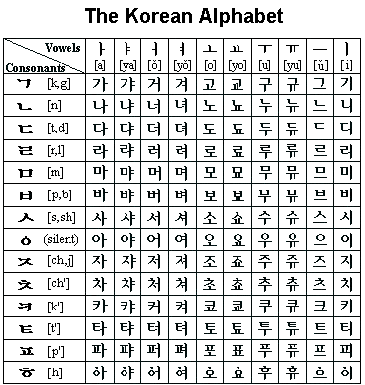|
Hangul
Koreans use their own unique alphabet called Hangul. It is considered to be one of the most efficient alphabets in the world and has garnered unanimous praise from language experts for its scientific design and excellence. Hangul was created under King Sejong during the Choson Dynasty (1393-1910). in 1446, the first Korean alphabet was proclaimed under the original name Hunmin chong-um, which literally meant "the correct sounds for the instruction of the people." King Sejong, the creator of Hangul, is considered to be one of the greatest rulers in the history of Korea. Highly respected for his benevolent disposition and diligence, King Sejong was also a passionate scholar whose knowledge and natural talent in all fields of study astounded even the most learned experts. During his reign, King Sejong always deplored the fact that the common people, ignorant of the complicated Chinese characters that were being used by the educated, were not able to read and write. He understood their frustration in not being able to read or to communicate their thoughts and feelings in written words. The Chinese script was used by the intelligentsia of the country, but being of foreign origin, it could not fully express the words and meaning of Korean thoughts and spoken language. Therefore, common people with legitimate complaints had no way of submitting their grievances to the appropriate authorities, other than through oral communication, and they had no way to record for posterity the agricultural wisdom and knowledge they had gained through years of experience. King Sejong felt great sympathy for the people. As a revolutionary ruler strongly dedicated to national identity and cultural independence, he immediately searched for solutions. What he envisioned was a set of letters that was uniquely Korean and easily learnable, rendering it accessible and usable for the common people. Thus, the Hunmin chong-um was born. In the preface of its proclamation, King Sejong states, "Being of foreign origin, Chinese characters are incapable of capturing uniquely Korean meanings. Therefore, many common people have no way to express their thoughts and feelings. Out of my sympathy for their difficulties, I have created a set of 28 letters. The letters are very easy to learn, and it is my fervent hope that they improve the quality of life of all people." The statement captures the essence of King Sejong's determination and dedication to cultural independence and commitment to the welfare of the people. When first proclaimed by King Sejong, Hunmin chong-um had 28 letters in all, of which only 24 are in use today. A Korean syllable is divided into three parts: Ch'osong (initial consonant), chungsong (peak vowel), and chongsong (final consonant). This is the basic framework that King Sejong and the Chiphyonjon scholars adhered to when created the letters. Chongsong was not separately created and was a repetition of the ch'osong. Therefore, Hangul is the consonants and vowels. The Korean language has a well-developed and expansive vocabulary, and therefore, it is very difficult to express fully in foreign letter. Because of its simplicity and the rather small number of letters, Hangul is very easy to learn even by children and foreigners. It is no coincidence that by the time they reach the ages of two or three, most Korean children are already capable of expressing their feelings and thoughts, albeit in primitive form. By the time they reach school age, most exhibit mastery of Hangul, which is indeed a rare phenomena throughout the world. This fact clearly attests to the easy learnability and accessibility of the Korean alphabet. Throughout history, Hangul has been at the root of the Korean culture, helping to preserve its national identity and independence. Illiteracy is virtually nonexistent in Korea. This is another fact that attests to the easy learnability of Hangul. It is not uncommon for a foreigner to gain a working knowledge of Hangul after one or two hours of intensive studying. In addition, because of its scientific design, Hangul lends itself to easy mechanization. In this age of computers into their lives without difficulties, thanks to a large number of programs written in Hangul. Links A English to Korean dictionary: http://www.zkorean.com/dictionary.shtml. Other links: Input Chinese, Japanese, and Korean text into any Microsoft Office product: http://www.microsoft.com/windows/ie/downloads/recommended/ime/default.mspx |
